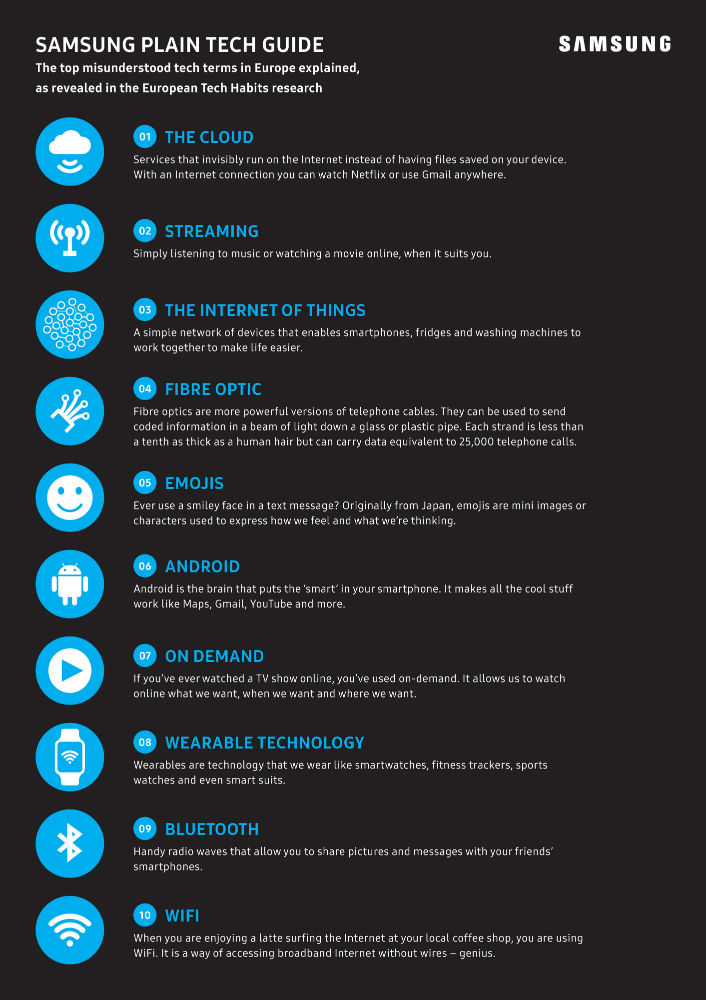Amazing Technology, Intimidating Terminology
UK on May 25, 2016
There’s no denying that technology can wow us with amazing experiences – virtual reality headsets, driverless cars, smart fridges – but as the pace of innovation quickens new research from Samsung Electronics shows Europeans are struggling to keep up with the changing language of tech. The new study from Samsung Europe shows that while excitement around technology is growing, the industry faces a growing risk of leaving consumers behind with confusing tech terminology.
Europeans are embracing the digital revolution like never before, with 52% of people revealing that they use technology much more than two years ago, and 13% admitting they couldn’t live without it. Over half of the 10,000 people surveyed across Europe are excited by the latest innovations like the Cloud or the Internet of Things, but nearly three quarters (72%) admitted that they often pretend to know what the latest tech terms really mean.
Nearly a quarter of people (23%) said confusing terminology prevents them from using a product to its full potential, 43% said that they owned at least one item of technology which was more advanced than they needed and 11% feel left behind by technology.
David Lowes, CMO of Samsung Electronics Europe, said: “Our research shows that terminology used in today’s technology can be a barrier for some consumers. We are taking a number of steps to address this, including simplifying the language we use and giving 400,000 young people digital skills training. However we believe this is an industry wide issue that will stand in the way of technological progress if left unchecked.
“As we push the boundaries of mobile, digital and TV technology even further, our industry has to be mindful of how we make the benefits accessible to everyone and support those who are not yet comfortable with the latest concepts like the Internet of Things. It’s important we bring everyone with us, which is why we invest heavily in creating products that are truly smart – simple, user friendly, secure and easy to understand. We also provide straightforward customer support from our experts online and in our retail outlets.”
The research was conducted by Samsung Electronics Europe amongst more than 10,000 Europeans across 18 countries to investigate how our relationship with technology is changing as part of its ongoing research. In response to the research, Samsung Europe has created a handy glossary ‘The Plain Tech Guide’ to explain what the latest terms mean and how they help our lives.
To ensure future generations are comfortable with the latest technology, Samsung is partnering with schools and universities to facilitate enhanced learning of digital skills through two core programmes: Smart Classrooms and Tech Institutes. Samsung’s goal is to directly reach 400,000 young people across Europe by 2020 making the pledge as part of the European Commission’s Grand Coalition for Digital Jobs. So far Samsung has set up over 600 smart classrooms, 48 tech institutes and engaged over 100,000 young people. Samsung is already starting to see positive outcomes from these efforts – 1 in 4 students in Samsung’s Digital Academies gained a place in higher level training before the end of their course*.
Europeans Love Emojis
While tech language develops, so does the way people are choosing to express themselves in visual forms. Emojis have been referred to as a new international language, but the Samsung study found that many people are struggling to get to grips with what these new characters really are. Romanians were found to be least familiar with them – 27% have pretended to know more than they do about emojis, closely followed by Italy (26%). In Bulgaria however, just one in 20 (5%) admitted to overstating their emoji knowledge.
Most Useful Apps
The research also investigated the apps which Europeans find most useful. Map apps were revealed to be the app which Europeans feel have had the biggest impact on them in terms of making their lives easier – something noted by 66%. This was followed by weather apps (56%) and phone cameras (51%).
David Lowes, CMO of Samsung Electronics Europe, said: “Despite predictions of fatigue with new devices, it is encouraging to see Europeans embrace their technology like never before. It’s great that 55% of people are excited by the latest innovations like the Galaxy S7 and Galaxy S7 edge, and we know from our sales that millions of Europeans have taken up our challenge to ‘rethink what a phone can do’. We seek to create products that are desirable, durable and user friendly, and this data is a useful reminder that we need to make sure we never let complex technical language stand in the way of useful innovation and progress.”
UNDERSTANDING ‘TECH-TERMINOLOGY’: the top five misunderstood tech terms explained
- The Cloud: Services that invisibly run on the Internet instead of having files saved on your device. With an Internet connection you can watch Netflix or use Gmail anywhere.
- Streaming: Simply listening to music or watching a movie online, when it suits you.
- The Internet of Things: A simple network of devices that enables smartphones, fridges and washing machines to work together to make life easier.
- Fibre optic: Fibre optics are more powerful versions of telephone cables. They can be used to send coded information in a beam of light down a glass or plastic pipe. Each strand is less than a tenth as thick as a human hair but can carry data equivalent to 25,000 telephone calls.
- Emojis: Ever use a smiley face in a text message? Originally from Japan, emojis are mini images or characters used to express how we feel and what we’re thinking.
*Source: The evaluation of the Smart Classroom and Digital Academy outcomes was carried out in 15 countries during the 2014/2015 academic year.

